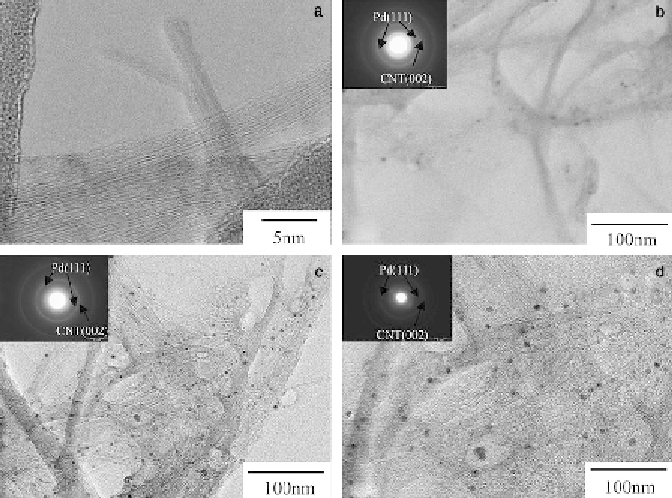Environmental Engineering Reference
In-Depth Information
values between 0.25 and 56 wt% reported under various experimental condi-
tions [2]. The very high values reported (30-60 wt%) have been questioned
and were later considered as possibly the result of measurement errors.
However, storage capacity of a few wt% is still considered as potentially
useful. Very recently, the hydrogen storage capacities have been reported at
ambient temperature to be 1.7, 1.85, 3.0, and 2.0 wt% for double-wall CNTs
(DWCNTs) loaded with 1, 1.0, 2.0, and 3.0 wt% Pd, respectively [6]. The
hydrogen storage capacity can be enhanced by loading with Pd nanoparticles
and selecting a suitable content, and the sorption was attributed to the chemi-
cal reaction between the atomic hydrogen and the dangling bonds of the
DWCNTs. Figure 7.2 shows TEM bright-field micrographs of loaded and
unloaded DWCNTs with different weight percentage of Pd and correspond-
ing selected area electron diffraction patterns. In another study, Pt decoration,
in conjunction with acidic etching, was found to substantially enhance hydro-
gen storage to a capacity of about 2.7 wt% [7]. It was suggested that the
acidic etching increased the surface defect density and led to opening up the
FIGURE 7.2
TEM bright-field micrographs of loaded and unloaded DWCNTs: (a) pristine DWCNTs;
(b) 1 wt%Pd/DWCNTs; (c) 2 wt%Pd/DWCNTs; and (d) 3 wt%Pd/DWCNTs, with insets in (b), (c), and
(d) showing the corresponding selected area electron diffraction patterns.
Source
: Reproduced with per-
mission from Wu et al. [6].

Search WWH ::

Custom Search